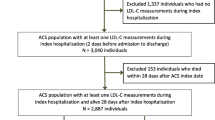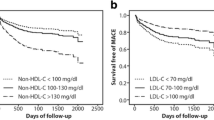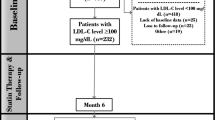Abstract
Introduction
To investigate the effect of combined lipid-lowering therapy on low-density lipoprotein cholesterol (LDL-C) variability and cardiovascular adverse events in patients with acute coronary syndrome (ACS).
Methods
A total of 200 patients with acute coronary syndrome, admitted to the first Hospital of Hebei Medical University from January 2018 to June 2019, were randomly divided into the observation group (100 cases were treated with combined lipid-lowering drugs, including 10 mg/day atorvastatin and 10 mg/day ezetimibe) and the control group (100 cases were given an intensive statin regimen, including 40 mg/day atorvastatin). The levels of blood lipids, creatine kinase (CK), alanine transaminase (ALT), matrix metalloproteinase-9 (MMP-9) and high-sensitivity C-reactive protein (hsCRP) were observed and compared between the two groups. Focus was laid on the concentration of the above-mentioned parameters and follow-up results including the drug safety and incidence of cardiovascular adverse events.
Results
Before treatment, there was no significant difference in total cholesterol (TC), high-density lipoprotein cholesterol (HDL-C), CK, ALT, MMP-9, hsCRP and LDL-C between the two groups (P > 0.05). After 6 months, 12 months and 24 months of treatment, TC, HDL-C, CK, ALT, MMP-9, hsCRP and LDL-C were improved in both groups, and TC, HDL-C, CK, ALT, MMP-9, hsCRP and LDL-C in the observation group elicited greater results than those in the control group with significant difference (P < 0.05). In the course of treatment, the drug safety of the two groups was compared (P > 0.05), and the incidence of cardiovascular adverse events in the observation group was significantly lower than that in the control group (6.59% vs. 11.96%) (P < 0.05).
Conclusion
Combination therapy with atorvastatin and ezetimibe potentially provides remarkable effects in terms of treating acute coronary syndrome, controlling the variation of LDL-C, alleviating the inflammatory state and reducing the incidence of cardiovascular adverse events with a safe profile. Combined lipid-lowering drugs are considered valid and alternative approaches for wide clinical practice.

Similar content being viewed by others
References
Ge JB, Dai YX. Status of diagnosis and treatment of non-ST-segment elevation acute coronary syndrome in China. Zhonghua Xin Xue Guan Bing Za Zhi. 2017;45(5):355–8.
Haraldsson I, Gan LM, Svedlund S, Torngren K, Westergren HU, Redfors B, et al. PROspective evaluation of coronary FLOW reserve and molecular biomarkers in patients with established coronary artery disease the PROFLOW-trial: cross-sectional evaluation of coronary flow reserve. Vasc Health Risk Manag. 2019;15:375–84.
Nardin M, Verdoia M. Impact of active smoking on the immature platelet fraction and its relationship with the extent of coronary artery disease. Eur J Clin Investig. 2019;50:e13181.
Zhao SP, Yu BL, Peng DQ, Huo Y. The effect of moderate-dose versus double-dose statins on patients with acute coronary syndrome in China: Results of the CHILLAS trial. Atherosclerosis. 2014;233(2):707–12.
Liang X, He Q, Zhao Q. Effect of Stains on LDL Reduction and Liver Safety: A Systematic Review and Meta-Analysis. BioMed Res Int. 2018;2018:7092414.
Johnson TA, Pfeffer SR. Ezetimibe-sensitive cholesterol uptake by NPC1L1 protein does not require endocytosis. Mol Biol Cell. 2016;27(11):1845–52.
Amsterdam EA, Wenger NK, Brindis RG, Casey DE Jr, Ganiats TG, Holmes DR Jr, Jaffe AS, Jneid H, Kelly RF, Kontos MC, Levine GN, Liebson PR, Mukherjee D, Peterson ED, Sabatine MS, Smalling RW, Zieman SJ. 2014 AHA/ACC Guideline for the Management of Patients with Non-ST-Elevation Acute Coronary Syndromes: a report of the American College of Cardiology/American Heart Association Task Force on Practice Guidelines. J Am Coll Cardiol. 2014 Dec 23;64(24):e139–e228. https://doi.org/10.1016/j.jacc.2014.09.017. Epub 2014 Sep 23. Erratum in: J Am Coll Cardiol. 2014 Dec 23;64(24):2713-4. Dosage error in article text. PMID: 25260718.
Zhu J, Quyyumi AA, Norman JE, Csako G, Waclawiw MA, Shearer GM, et al. Effects of total pathogen burden on coronary artery disease risk and C-reactive protein levels. Am J Cardiol. 2000;85(2):140–6.
Schieffer B, Schieffer E, Hilfiker-Kleiner D, Hilfiker A, Kovanen PT, Kaartinen M, et al. Expression of angiotensin II and interleukin 6 in human coronary atherosclerotic plaques: potential implications for inflammation and plaque instability. Circulation. 2000;101(12):1372–8.
Baigent C, Blackwell L, Emberson J, Holland LE, Reith C, Bhala N, et al. Efficacy and safety of more intensive lowering of LDL cholesterol: a meta-analysis of data from 170,000 participants in 26 randomised trials. Lancet. 2010;376(9753):1670–81.
Maxwell PR, Timms PM, Chandran S, Gordon D. Peripheral blood level alterations of TIMP-1, MMP-2 and MMP-9 in patients with type 1 diabetes. Diabet Med. 2001;18(10):777–80.
Bays H, Sapre A, Taggart W, Liu J, Capece R, Tershakovec A. Long-term (48-week) safety of ezetimibe 10 mg/day coadministered with simvastatin compared to simvastatin alone in patients with primary hypercholesterolemia. Curr Med Res Opin. 2008;24(10):2953–66.
Masana L, Mata P, Gagne C, Sirah W, Cho M, Johnson-Levonas AO, et al. Long-term safety and tolerability profiles and lipid-modifying efficacy of ezetimibe coadministered with ongoing simvastatin treatment: a multicenter, randomized, double-blind, placebo-controlled, 48-week extension study. Clin Ther. 2005;27(2):174–84.
Hagiwara N, Kawada-Watanabe E, Koyanagi R, Arashi H, Yamaguchi J, Nakao K, et al. Low-density lipoprotein cholesterol targeting with pitavastatin + ezetimibe for patients with acute coronary syndrome and dyslipidaemia: the HIJ-PROPER study, a prospective, open-label, randomized trial. Eur Heart J. 2017;38(29):2264–76.
Liu P, Jiang J, Li J, Hong T, Zhang Y, Yu R, et al. Intensive statin therapy for Chinese patients with coronary artery disease undergoing percutaneous coronary intervention (ISCAP study): rationale and design. Catheter Cardiovasc Interv. 2012;79(6):967–71.
Dohi T, Miyauchi K, Okazaki S, Yokoyama T, Yanagisawa N, Tamura H, et al. Early intensive statin treatment for six months improves long-term clinical outcomes in patients with acute coronary syndrome (Extended-ESTABLISH trial): a follow-up study. Atherosclerosis. 2010;210(2):497–502.
Zhu Y, Hu H, Yang J, Yao Q, Xu H, Yu Y, et al. The efficacy and safety of statin in combination with ezetimibe compared with double-dose statin in patients with high cardiovascular risk: a meta-analysis. Bosn J Basic Med Sci. 2019;20:169.
Acknowledgements
We thank the participants of the study.
Funding
This study was supported by 2017 Clinical Medicine Excellent Talents Training Fund from Hebei Provincial Government (No. HBWJ2017BJ50).
Authorship
All named authors meet the International Committee of Medical Journal Editors (ICMJE) criteria for authorship for this article, take responsibility for the integrity of the work as a whole, and have given their approval for this version to be published.
Compliance with Ethics Guidelines
The study was approved by the ethics committee of the First Hospital of Hebei University (no. 20190589). All participants signed informed consent. This study was performed in accordance with the Helsinki Declaration of 1964 and its later amendments.
Disclosures
Huilian Tan, Ling Liu, Qinghou Zheng, Dahong Zhang, Qian Liu, Dong Cui, Lei Gao, Zhen Wang, Wen-Lei Wang and Jun Liu have nothing to disclose.
Authorship Contributions
HTL, LL and JL contributed to the design of the study. QZ, DZ, QL, DC and ZW dealt with patients’ follow-up and contributed to the analysis. QZ, DZ and QL contributed to the interpretation of data. HTL and WW drafted the manuscript. All the authors critically revised the manuscript and gave final approval and agree to be accountable for all aspects of the work, ensuring both its integrity and accuracy.
Data Availability
All data generated or analyzed during this study are included in this published article/as supplementary information files.
Author information
Authors and Affiliations
Corresponding author
Rights and permissions
About this article
Cite this article
Tan, H., Liu, L., Zheng, Q. et al. Effects of Combined Lipid-Lowering Therapy on Low-Density Lipoprotein Cholesterol Variability and Cardiovascular Adverse Events in Patients with Acute Coronary Syndrome. Adv Ther 38, 3389–3398 (2021). https://doi.org/10.1007/s12325-021-01741-7
Received:
Accepted:
Published:
Issue Date:
DOI: https://doi.org/10.1007/s12325-021-01741-7




